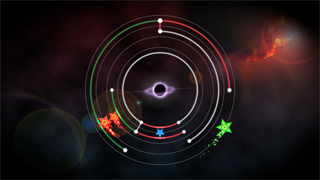





| Title | ORBITS |
|---|---|
| Platform | PC |
| School | HAL Tokyo |
| Winner's name | OVERWORKS |
Congratulations on winning the award.
The developer could fully utilize the theme of ☆ in the game design and construct the game as a unique genre. The developer successfully applied the theme into the game in an easy way. Everyone can play the game easily with simple operation of “drawing” and “separating” ☆ in a wide variety of difficulty levels.
This is the most complete game among many entries. The tutorial elements according to the progress of the game and the appearance of new puzzle elements in the progress of stages are well designed at stages. With the used sound, high sense of immersion and addictiveness are created. Use of a same BGM without any pause through the stage is a nice idea. This game gave me such joy that I felt like playing this game after the review.
Manabu Shimomoto, BANDAI NAMCO Entertainment
Soon after I started to play the game, I thought, “Wow, this is interesting!”
The basic rule is very simple: “Three colored stars are moving in orbits of several concentric circles. Move them all together to the inner or the outer orbit and unit them.” When any star goes beyond an inner or outer partitionless area, the game is over.
One stage has no entry wall on the orbit, and another has a wall that separates a united star into three again. The game has a very simple rule and at the same time, “worries a player with delight.” After badly bothering about the location to move, wondering “where I should move this”, it was quite exciting when I realized it, saying “Oh, this is it!”
In addition, I felt we should highly evaluate the intuitive operation such as tilting the left or right stick inward or outward, and the unity of the game including graphics and SE, which are simple but suitable to the world view.
Congratulations on winning the award. I do hope many people play this game.
Akira Chigira, KADOKAWA Corporation
This is an action puzzle game to complete a white star by drawing three colored stars inward or moving them outward to unite them all.
The game is over if the player lets a star goes out from the partitionless inside and outside areas with his/her guard down. Though the operation, which is just “drawing and separating,” is simple, gimmicks featuring various characteristics enhance the strategical character of the game. For example, a star can sneak through a same colored wall. If same colored stars come into collision with each other, they start reverse rotation. We can enjoy a special exhilarating feeling in clearing the game.
And stages gradually get more difficult, and the game provides detailed tutorials. The game is highly completed including graphics, SE, and BGM suitable to the world view.

